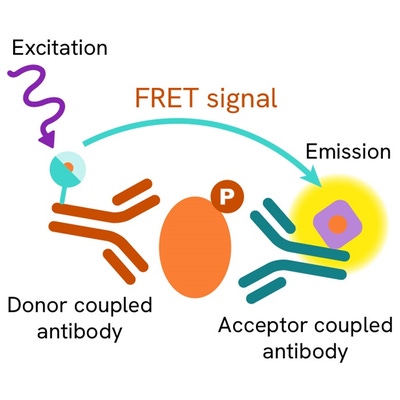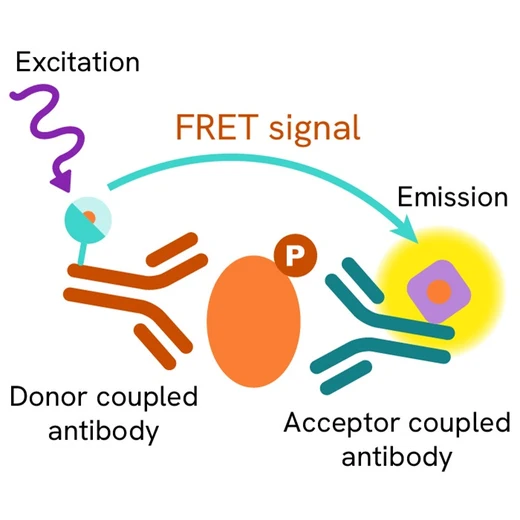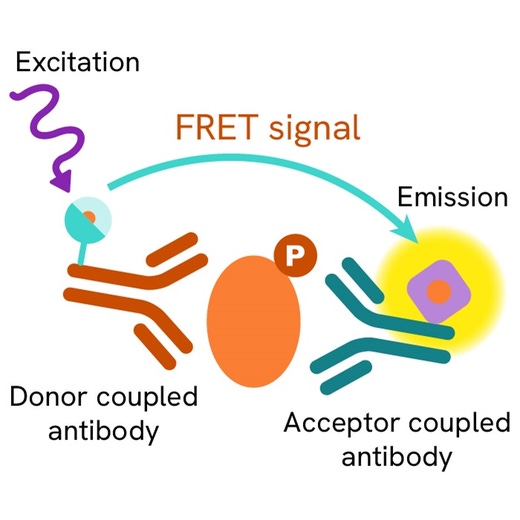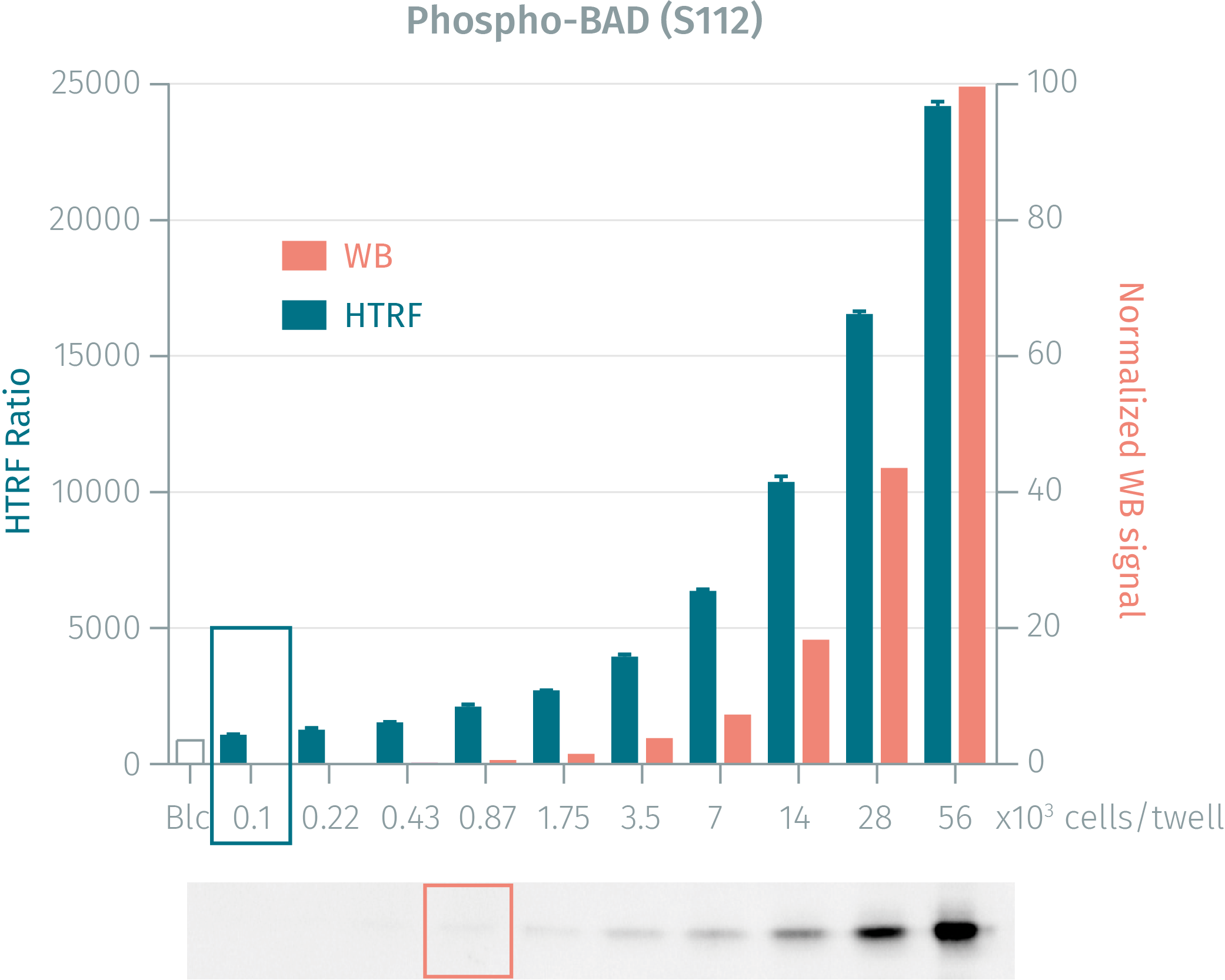

HTRF Human Phospho-BAD (Ser112) Detection Kit, 96 Assay Points








| Feature | Specification |
|---|---|
| Application | Cell Signaling |
| Sample Volume | 16 µL |









Product information
Overview
The Phospho-Bad (Ser112) cellular kit is designed for the streamlined and efficient quantification of phosphorylated BAD proteins in cell lysates.This fast and convenient, no-wash protocol offers highly sensitive results and can be applied to all steps of the drug discovery process, from basic research to High Throughput screening.
How it works
Phospho-BAD (Ser112) Assay principle
The Phospho-BAD (Ser112) assay measures BAD when phosphorylated at Ser112. Contrary to Western Blot, the assay is entirely plate-based and does not require gels, electrophoresis or transfer. The Phospho-BAD (Ser112) assay uses 2 labeled antibodies: one with a donor fluorophore, the other one with an acceptor. The first antibody is selected for its specific binding to the phosphorylated motif on the protein, the second for its ability to recognize the protein independent of its phosphorylation state. Protein phosphorylation enables an immune-complex formation involving both labeled antibodies and which brings the donor fluorophore into close proximity to the acceptor, thereby generating a FRET signal. Its intensity is directly proportional to the concentration of phosphorylated protein present in the sample, and provides a means of assessing the proteins phosphorylation state under a no-wash assay format.

Phospho-BAD (Ser112) 2-plate Assay protocol
The 2 plate protocol involves culturing cells in a 96-well plate before lysis then transferring lysates to a 384-well low volume detection plate before adding phospho-BAD (Ser112) HTRF detection reagents. This protocol enables the cells' viability and confluence to be monitored.

Phospho-BAD (Ser112) 1-plate assay protocol
Detection of Phosphorylated BAD (Ser112) with HTRF reagents can be performed in a single plate used for culturing, stimulation and lysis. No washing steps are required. This HTS designed protocol enables miniaturization while maintaining robust HTRF quality.

Assay validation
WB versus HTRF assay for Phoshpo-BAD (Ser112) kit
Cos-7 cells were grown in a T175 flask at 37°C, 5% CO2, for 1 day. Day 2: After removal of cell culture medium, 3 mL of supplemented lysis buffer were added and incubated for 30 minutess. Soluble supernatants were collected after a 10 minute centrifugation. Equal amounts of lysates were used for a side by side comparison of Western Blot and HTRF.220 cells can be detected by using HTRF phospho-Bad (Ser112) wheras1750 cells are needed for the Western Blot. The HTRF assay is 4-fold more sensitive than Western Blot.

PMA dose-response on HEK293 cells for Phospho-BAD (Ser112) kit
Human HEK293 cells (100,000 cells/well) were stimulated for 30 minutess at 37°C with various concentrations of PMA. After 30 minutess of lysis incubation, phosphorylated Bad was measured using the two-plate assay protocol.

Staurosporine inhibition on stimulated MCF7 and Cos-7 cells
Human MCF7 and monkey Cos-7 cells (25,000 cells/well) were incubated for 3 hours at 37°C with various concentrations of Staurosporin inhibitor. Then 0.8 µM of PMA was added for cell stimulation, and sampes were incubated for 30 minutess. After 30 minutess of lysis incubation, inhibition of Bad phosphorylation was measured using the HTRF Phospho-Bad (Ser112) assay with the two-plate protocol.

Simplified pathway
Simplified pathway of pro-apoptotic factor Bad signaling
Bad is a pro-apoptotic factor belonging to the Bcl-2 family of proteins and governs mitochondrial membrane permeability by regulating cytochrome C release. In healthy, proliferating cells, Bad is phosphorylated and sequestered in the cytosol while in stressed cells, death stimuli induce Bad dephosphorylation and its translocation to the mitochondrial membrane, where it neutralizes Bcl-Xl or BCl-2 by heterodimerization and thus induces cytochrome C release, leading to apoptosis.

Specifications
| Application |
Cell Signaling
|
|---|---|
| Brand |
HTRF
|
| Detection Modality |
HTRF
|
| Lysis Buffer Compatibility |
Lysis Buffer 3
|
| Molecular Modification |
Phosphorylation
|
| Product Group |
Kit
|
| Sample Volume |
16 µL
|
| Shipping Conditions |
Shipped in Dry Ice
|
| Target Class |
Phosphoproteins
|
| Target Species |
Human
|
| Technology |
TR-FRET
|
| Therapeutic Area |
Oncology & Inflammation
|
| Unit Size |
96 assay points
|
Video gallery
Resources
Are you looking for resources, click on the resource type to explore further.
This guide provides you an overview of HTRF applications in several therapeutic areas.


Loading...
How can we help you?
We are here to answer your questions.






























